
Using LED Grow Lights To Maximise Cannabis Yields
Choice; a wonderful freedom or a terrible burden? Choosing how to set up your cannabis grow requires a lot of decisions, not least of all when it comes to lighting. Find out all about LED lights, the different types, how best to use them, and much more in our guide.
Lights are perhaps the most important bit of equipment for an indoor cannabis grow, and can make the difference between a massive yield of the dankest bud, and sub-par little popcorn buds. So choosing the right grow lights is essential. But with so many out there, where to begin?
LEDs have come a long way in the last few years, and might be on their way to becoming the top choice for cannabis growers. However, there are some things you need to know about them before you set out. LEDs are incredibly versatile—this is their greatest strength. But you can also come across LED lights that will provide nothing of benefit to your cannabis plants. So take a look at the information below before shopping for LEDs to outfit your cannabis grow-op.
What are LED grow lights and why use them?
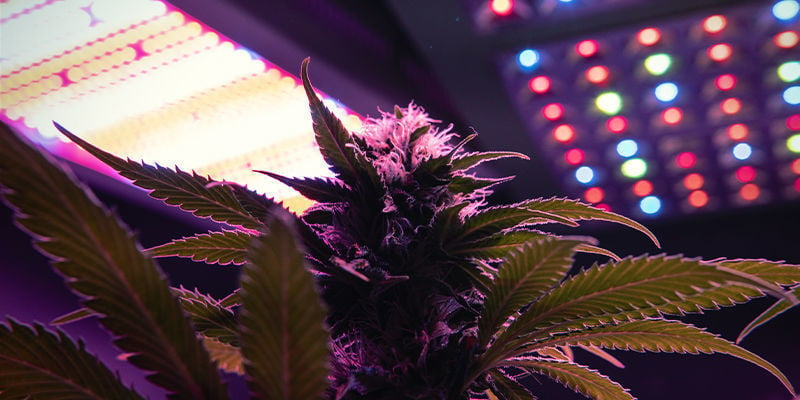
LED stands for "light-emitting diode". It is an incredibly energy-efficient type of lighting, capable of emitting very strong light, at a low temperature, for potentially years at a time.
Due to the small size of each diode and the versatility of the technology, LEDs can fulfil many, many functions. From Christmas tree lights, to street lights, to full-spectrum grow lights, they are becoming the obvious choice.
Some advantages of LED grow lights are:
- Cheap to run
- Cool to run
- Full spectrum of light
- Adjustable spectrums—one light for the whole grow
- Potentially encourages greater trichome development
- Saves water (through less evaporation)
- Due to lack of heat, you can place them closer to cannabis plants, increasing light exposure
Some disadvantages of LEDs are:
- Poor-quality LEDs will not produce a suitable light spectrum for cannabis plants
- Hard to know whether a manufacturer makes genuinely good ones
- Lack of heat can be a drawback in winter
- Anecdotal evidence suggests LEDs may halt autoflowering plants during flowering (more on this later)
However, with recent developments in LED lighting, if you’re willing to do some research and invest in a good one, it is a very good option for indoor marijuana growing.
What LED grow light should I buy?
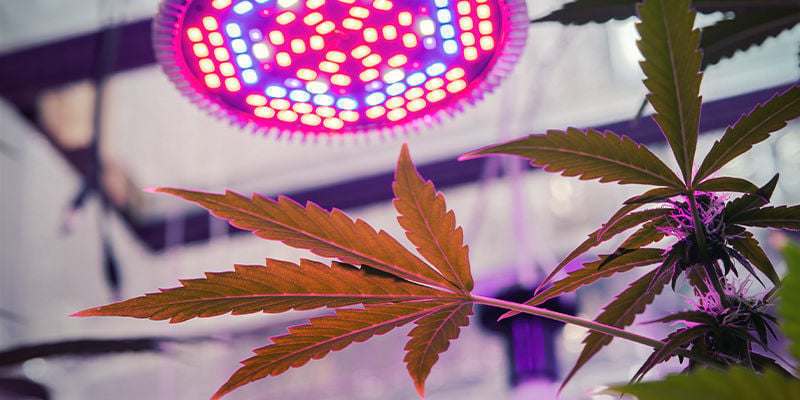
Purchasing the correct type of LED grow light will ensure you're capable of securing a glistening haul of trichome-covered buds. You’ll need to know the wattage and the light spectrum to make an informed choice. Animals tend to respond to lumens: the brightness of light. Plants, on the other hand, react to the frequency of light, so it’s important to check the stats. A super-bright light of the wrong frequency will gain you nothing.
Different types of LED grow lights
There are three main types of LED light, each with their own advantages and disadvantages. If you’re serious about your cannabis grow, higher-quality models will yield significantly better results. And as LEDs last for years, if you’re going to keep growing in the future, you might as well invest in a good one now.
Standard purple LED
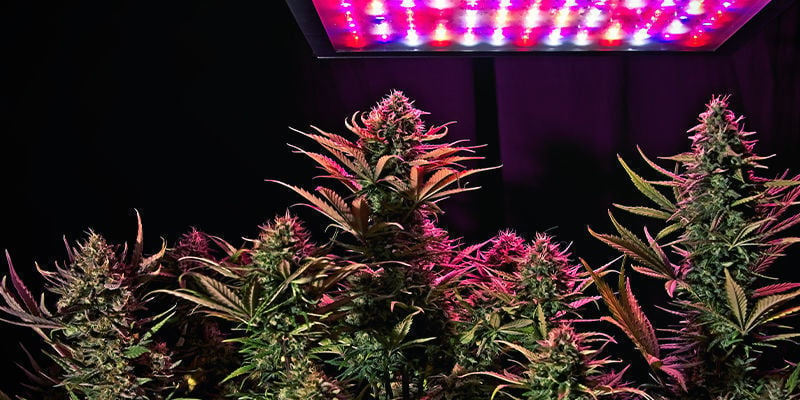
These are the original LED grow light, and come with a mixture of red and blue diodes that together emit a purple light. The blue light helps the plant in the early stages of its life; the red in the latter. Some lights emit the same hue throughout the whole grow, whereas others have settings for both the vegetative and flowering stages.
These are the cheapest LED option, but arguably the worst too. Mass manufacturing impacts reliability, and it can be hard to know whether the light spectrum is within the necessary frequencies.
COB LED
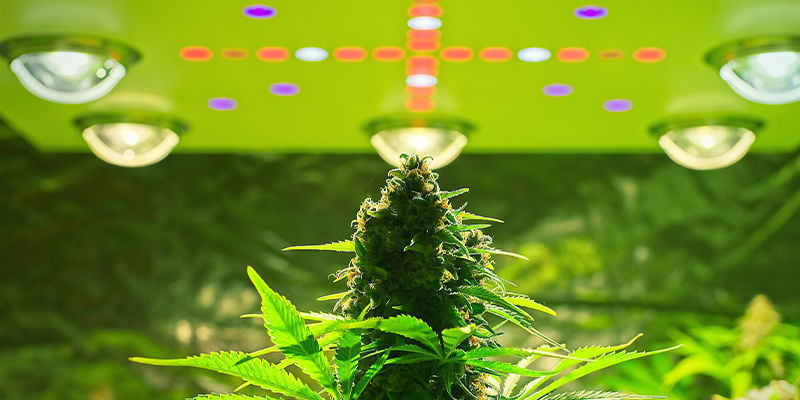
COB lights are one of the best-quality LED options available, and unsurprisingly one of the most expensive. COB means “chip on board”, and they are made up of many very small LEDs that combine to emit a bright white light.
This intense light penetrates the canopy well and delivers a full spectrum of light to your plants. While some come with veg and bloom settings, most have just one setting that will suffice for the entire grow.
These can be combined in large spreads, making them suitable for larger grow spaces.
Spread-style LED
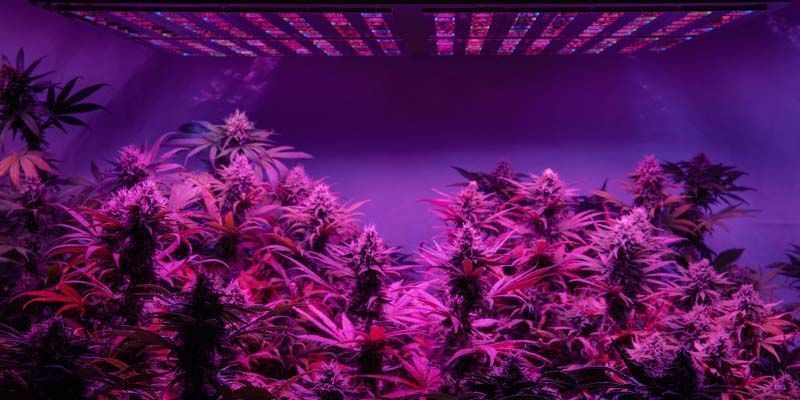
These utilise a large number of smaller LEDs spread across a board. They are extremely energy efficient and provide a great light spectrum and light intensity for your plants. Commercial cannabis growers tend to use this option.
Variations, such as spider styles, are also available. These have long arms that come down, allowing you to adjust them around your grow for optimal lighting.
As you may expect, these tend to be the most expensive option.
What size of LED grow light do I need?
LED size, or power, should be commensurate to the size of your grow. For a one metre squared grow, a light of around 400–600W would be ideal. As a general rule in the growing world, 1 watt of light tends to correspond to between 0.5 and 1 gram of cannabis come harvest time. This depends on much more than just light, but it’s a good way to figure out how much wattage you should use.
LED grow lights with a veg/bloom switch
As mentioned, many LED lights come with a switch to move from the vegetative stage to the flowering stage. This changes the spectrum from blue (veg) to red (flowering), mirroring the sun’s frequency at different times of year. It is not entirely clear whether this is better than a grow light that emits a full spectrum all of the time, but it is likely to use less energy, as the unnecessary frequencies are switched off. So in the pursuit of cheap bills and a cooler climate, it’s no bad option!
How many LED grow lights do I need?
To figure this out, you have to think in terms of coverage. You want your whole canopy to receive pretty equal light intensity. Often, one good grow light will suffice. However, if you’ve a big space with lots of plants, a combination of either fewer, bigger lights or more, smaller lights might work better. It all depends on the space and your setup. For instance, if you’re going to use SOG or ScrOG training techniques, you will have to adjust your LED setup accordingly.
Growing weed with LED grow lights
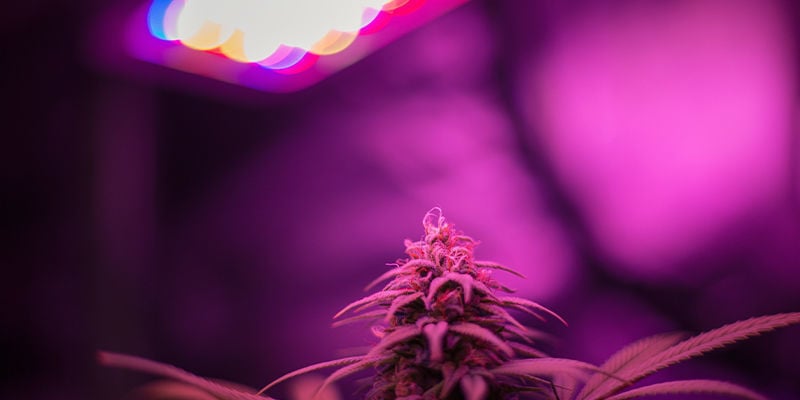
Using LEDs to grow weed is pretty straightforward, especially with full-spectrum lights or those with a switch. It means there’s no need to change your rigging over. Nevertheless, there are some important factors to be aware of during each stage of the cannabis growing cycle.
LED grow lights and the seedling stage
The seedling stage is when cannabis plants are most vulnerable and require the most care. If using LED lights, be careful not to subject your seedlings to too much light. If your LED has a dimming option, consider using this. If not, move the light away a little. That being said, you’ll need to take cues from the plant itself. If it shoots upward and begins to look spindly, you’re not giving it enough light and it is stretching. Without remedy, it risks falling over.
If the grow light has a veg/bloom switch, have it on veg so it receives a blue spectrum. This helps with root development, which is crucial at this stage. Switch to an 18/6 light cycle for this stage, or up to 24/0 for autoflowering plants.
LED grow lights and the vegetative stage
The vegetative stage requires more or less the same setup as the seedling stage, except your plants can take greater light intensity. You still don’t want to burn them, though! Watch for discolouration and curling on the upper leaves. If you see it, move the lights a little further away. Other than increasing light intensity, keep the settings the same as before.
As before, if it continues to grow upward, getting tall and spindly, this is a sign that your cannabis plant wants more light. Though it will of course grow upward, most healthy plants also exhibit a lot of outward, bushy growth. The exception to this rule is some sativa strains, which may look as though they are stretching regardless of environmental conditions.
LED grow lights and the flowering stage
For the flowering stage, switch to the bloom (red) option if you have it. To make a photoperiod cannabis plant flower, you’ll have to set a 12/12 light cycle, else it will just keep vegging. Once again, watch for light burn and stretching, and keep the grow light at the optimal distance.
Can you grow autoflowering cannabis with LED grow lights?
Yes, you can. On the whole, it seems to work just as well as with photoperiod plants. However, there have been some anecdotal reports of autoflowering plants freezing in the early flowering stage under LED lights. However, if this is true at all, it seems to be fairly anomalous and shouldn’t dissuade you from trying it out.
How far should LED grow lights be from my marijuana plants?
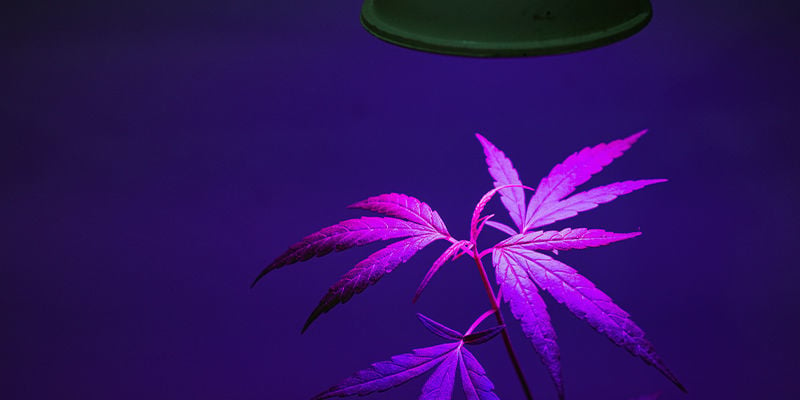
To answer this, you need to know the strength of your lights and the growing stage of your cannabis plants. Combining the information above with manufacturer instructions should help you figure it out.
A great advantage of LED lights is that they can be placed much closer to your weed plants without the risk of burning. This helps to maximise light exposure and potentially increase yields! Play around and watch your plants. Basically, you want your lights to be as close to the canopy as possible without burning the plants. Beyond the seedling stage, you can afford to find out what this distance is as long as you react quickly.
Can LED grow lights burn cannabis plants?
Despite being able to place LEDs much closer, they can still burn your plants. The good news is, it should be more gradual, and so long as you’re taking notice, you should be able to fix any problems before they cause any real damage to your cannabis plants. Thanks to their coolness, placing LEDs too close is not going to immediately fry the upper leaves.
Are LED grow lights as good as HPS?
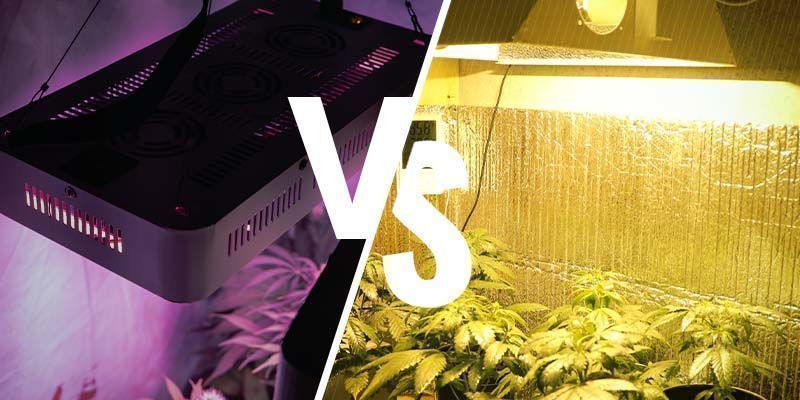
This is a long-term debate that won’t be laid to rest here. Nonetheless, on the whole we’d say “yes”. HPS are certainly the old favourite, and have been responsible for the best-quality indoor weed for decades, so many indoor growers are reluctant to let them go. But while they undoubtedly produce high yields of high-quality bud, they are expensive to run, hot, and cumbersome.
LEDs, on the other hand, are cheap to run, don’t devour energy, and remain cool. This makes them much better for a home grow, as they are smaller and don’t require ventilation. The downside is that, unlike the HPS market, the LED market is still not standardised, and figuring out what you’re actually getting can be tricky. With HPS, you’ll know exactly what’s in the box.
Those are the differences in terms of setup, but what about results? HPS are incredibly intense and tend to eke the greatest harvest in terms of quantity. LEDs are less powerful and can result in slightly smaller yields, but many claim that they produce higher-quality buds.
So, what do you want? Quantity or quality?
-
 7 min
10 January 2022
Cannabis Grow Lights: LED Vs HPS
HPS grow lights have long been the standard among indoor cannabis growers. LEDs, on the other hand, are the new kid on the block, generating a lot of hype, and not always in a good way. In this...
7 min
10 January 2022
Cannabis Grow Lights: LED Vs HPS
HPS grow lights have long been the standard among indoor cannabis growers. LEDs, on the other hand, are the new kid on the block, generating a lot of hype, and not always in a good way. In this...
-
 4 min
17 December 2021
Do You Need Side Lighting For Cannabis Plants?
Some cannabis growers use side lighting to better penetrate their canopy and increase their yields. While this method undoubtedly pushes productivity to the max, are the extra running costs worth...
4 min
17 December 2021
Do You Need Side Lighting For Cannabis Plants?
Some cannabis growers use side lighting to better penetrate their canopy and increase their yields. While this method undoubtedly pushes productivity to the max, are the extra running costs worth...
-
 7 min
11 November 2021
How The Light Spectrum Affects Cannabis
Cannabis is a sun-loving plant. But growing great weed indoors is about more than just sticking a plant under a strong light and hoping for the best. In this article, we'll teach you all there is...
7 min
11 November 2021
How The Light Spectrum Affects Cannabis
Cannabis is a sun-loving plant. But growing great weed indoors is about more than just sticking a plant under a strong light and hoping for the best. In this article, we'll teach you all there is...
-
 5 min
20 October 2020
The Optimal Distance Between Grow Lights And Cannabis Plants
Hanging a grow light in your grow room or tent is just one part of the story. To really get the most out of your cannabis plants, you need to hang your light at the optimal height to support robust...
5 min
20 October 2020
The Optimal Distance Between Grow Lights And Cannabis Plants
Hanging a grow light in your grow room or tent is just one part of the story. To really get the most out of your cannabis plants, you need to hang your light at the optimal height to support robust...
-
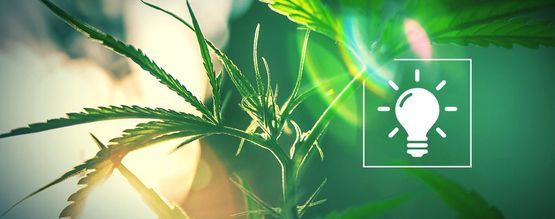 7 min
13 June 2019
Choosing The Right Light For Your Grow-Op
Cannabis plants have many demands, but none quite as important as lighting. A good set of lights are needed to ensure plants can photosynthesise properly and make enough energy to survive and...
7 min
13 June 2019
Choosing The Right Light For Your Grow-Op
Cannabis plants have many demands, but none quite as important as lighting. A good set of lights are needed to ensure plants can photosynthesise properly and make enough energy to survive and...









 United States
United States













